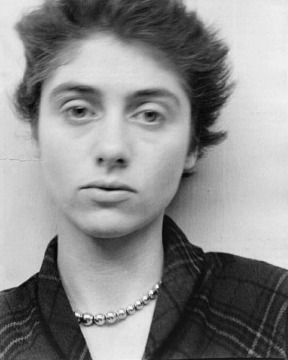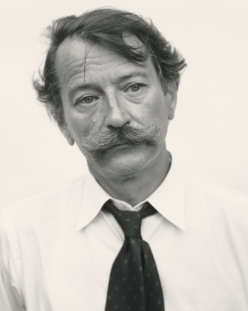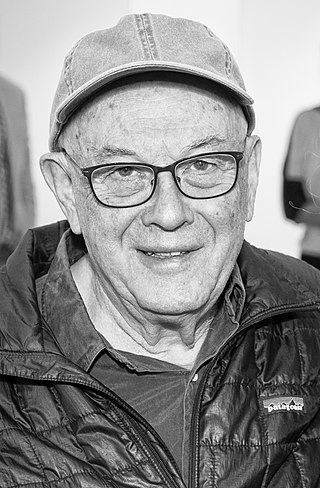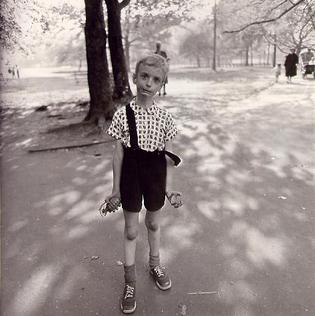Related Research Articles

Diane Arbus was an American photographer. She photographed a wide range of subjects including strippers, carnival performers, nudists, people with dwarfism, children, mothers, couples, elderly people, and middle-class families. She photographed her subjects in familiar settings: their homes, on the street, in the workplace, in the park. "She is noted for expanding notions of acceptable subject matter and violates canons of the appropriate distance between photographer and subject. By befriending, not objectifying her subjects, she was able to capture in her work a rare psychological intensity." In his 2003 New York Times Magazine article, "Arbus Reconsidered", Arthur Lubow states, "She was fascinated by people who were visibly creating their own identities—cross-dressers, nudists, sideshow performers, tattooed men, the nouveaux riches, the movie-star fans—and by those who were trapped in a uniform that no longer provided any security or comfort." Michael Kimmelman writes in his review of the exhibition Diane Arbus Revelations, that her work "transformed the art of photography ". Arbus's imagery helped to normalize marginalized groups and highlight the importance of proper representation of all people.

Street photography is photography conducted for art or enquiry that features unmediated chance encounters and random incidents within public places. Although there is a difference between street and candid photography, it is usually subtle with most street photography being candid in nature and some candid photography being classifiable as street photography. Street photography does not necessitate the presence of a street or even the urban environment. Though people usually feature directly, street photography might be absent of people and can be of an object or environment where the image projects a decidedly human character in facsimile or aesthetic.

Garry Winogrand was an American street photographer, known for his portrayal of U.S. life and its social issues, in the mid-20th century. Photography curator, historian, and critic John Szarkowski called Winogrand the central photographer of his generation.
Lee Friedlander is an American photographer and artist. In the 1960s and 1970s, Friedlander evolved an influential and often imitated visual language of urban "social landscape," with many of his photographs including fragments of store-front reflections, structures framed by fences, posters and street signs.

Thaddeus John Szarkowski was an American photographer, curator, historian, and critic. From 1962 to 1991 Szarkowski was the director of photography at New York's Museum of Modern Art (MoMA).

A snapshot is a photograph that is "shot" spontaneously and quickly, most often without artistic or journalistic intent and usually made with a relatively cheap and compact camera.
Documentary photography usually refers to a popular form of photography used to chronicle events or environments both significant and relevant to history and historical events as well as everyday life. It is typically undertaken as professional photojournalism, or real life reportage, but it may also be an amateur, artistic, or academic pursuit.
The term vernacular photography is used in several related senses. Each is in one way or another meant to contrast with received notions of fine-art photography. Vernacular photography is also distinct from both found photography and amateur photography. The term originated among academics and curators, but has moved into wider usage.

Henry Wessel was an American photographer and educator. He made "obdurately spare and often wry black-and-white pictures of vernacular scenes in the American West".

Bruce Landon Davidson is an American photographer. He has been a member of the Magnum Photos agency since 1958. His photographs, notably those taken in Harlem, New York City, have been widely exhibited and published. He is known for photographing communities usually hostile to outsiders.

Child with Toy Hand Grenade in Central Park, N.Y.C. 1962 (1962) is a famous black and white photograph by Diane Arbus.
William Gale Gedney was an American documentary and street photographer. It wasn't until after his death that his work gained momentum and is now widely recognized. He is best known for his series on rural Kentucky, and series on India, San Francisco and New York shot in the 1960s and 1970s.
Nathan Lyons was an American photographer, curator, and educator. He exhibited his photographs from 1956 onwards, produced books of his own and edited those of others.

Bill Dane is a North American street photographer. Dane pioneered a way to subsidize his public by using photographic postcards. He has mailed over 50,000 of his pictures as photo-postcards since 1969. As of 2007, Dane's method for making his photographs available shifted from mailing photo-postcards to offering his entire body of work on the internet.
Leo Rubinfien is an American photographer and essayist who lives and works in New York City. Rubinfien first came to prominence as part of the circle of artist-photographers who investigated new color techniques and materials in the 1970s.
Keith A. Smith is an American artist and author. He has taught at the Visual Studies Workshop, the School of the Art Institute of Chicago, and the University of Illinois. He is a recipient of two Guggenheim Fellowships, a National Endowment of the Arts grant and a Pollock-Krasner Foundation grant. Smith creates books as works of art, as well as instructional texts on how to make books. Permanent collections which hold works by Smith include the National Gallery of Art, Museum of Modern Art, the National Gallery of Canada, and the Center for Creative Photography.

Fraenkel Gallery is a contemporary art gallery in San Francisco founded by Jeffrey Fraenkel in 1979. Frish Brandt, president of the gallery, joined in 1985.
Sandra S. "Sandy" Phillips is an American writer, and curator working in the field of photography. She is the Curator Emeritus of Photography at the San Francisco Museum of Modern Art. She joined the museum as curator of photography in 1987 and was promoted to senior curator of photography in 1999 in acknowledgement of her considerable contributions to SFMOMA. A photographic historian and former curator at the Vassar College Art Gallery in Poughkeepsie, N.Y., Phillips succeeded Van Deren Coke as head of one of the country’s most active departments of photography. Phillips stepped down from her full time position in 2016.
Michael Jang is an American documentary photographer. Jang is best known for his 1970s photographs of life in Los Angeles and San Francisco, with subjects ranging from his family to punk bands and street scenes.
Simpson Kalisher is an American photojournalist and street photographer.
References
- 1 2 3 4 5 Gefter, Philip (9 July 2007). "John Szarkowski, Curator of Photography, Dies at 81". The New York Times . Retrieved 26 December 2014.
- ↑ Mora, Gilles (2007). The Last Photographic Heroes: American Photographers of the Sixties and Seventies. New York, NY: Abrams Books. pp. 40–50. ISBN 978-0810993747.
- 1 2 3 O'Hagan, Sean (20 July 2010). "Was John Szarkowski the most influential person in 20th-century photography?". The Guardian . Retrieved 26 December 2014.
- ↑ Rourke, Mary (10 July 2007). "John Szarkowski; curator elevated art of photography". The Boston Globe . Retrieved 26 December 2014.
- 1 2 "No. 21" (PDF). Museum of Modern Art . Retrieved 26 December 2014.
- ↑ Warren, Lynne (2006). Encyclopedia of Twentieth-Century Photography. London: Routledge. ISBN 978-1-57958-393-4 . Retrieved 27 December 2014.
- 1 2 3 Leo, Rubinfien (2013). Garry Winogrand. San Francisco: San Francisco Museum of Modern Art. p. 428. ISBN 0-300-19177-4.
- ↑ Galassi, Peter (2005). Friedlander. New York: Museum of Modern Art. p. 460. ISBN 0-87070-343-9.